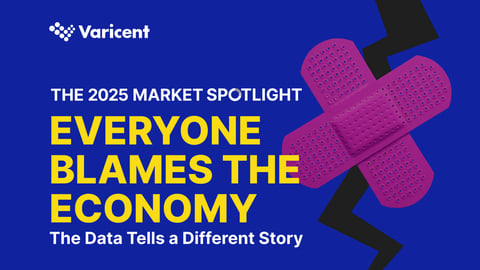This is part of a series of interviews with B2B revenue leaders. This interview is with Seth Lieberman, former CEO of SnapApp.
 Today, I'm talking with Seth Lieberman. A former banker turned serial entrepreneur and the Founder and CEO of SnapApp. It's a pleasure to talk with you, Seth.
Today, I'm talking with Seth Lieberman. A former banker turned serial entrepreneur and the Founder and CEO of SnapApp. It's a pleasure to talk with you, Seth.
Thanks, Dan. It’s great to be here.
Let's start with by talking a little bit about SnapApp, give us the 30-second pitch on what SnapApp is all about and your role with the company.
So, I'm the Founder and CEO of SnapApp.
SnapApp is a platform to build interactive content experiences. In this buyer-driven, buyer-centered world that we live, marketers need efficient and easy ways to create amazing experiences that not only educate, inform, and help prospects identify their pains and needs, but also provide deep insights into their marketing automation and CRM.
With this information you can better understand who your best leads are, and you can deliver a better content experience.
To start out, I'm going to go with a very general question and see where it goes; how do you see sales and marketing teams working together?
It's all over the board, but as a whole, Sales and Marketing alignment is getting better.
With the companies that we work with, we often see that Marketing talks about MQLs, and Sales talks about SQLs. Our goal with these companies is to focus on closing that gap between what a MQL and what a SQL is, and make those two terms more aligned. The more that those two terms overlap, the better aligned the two teams are.
Companies who are doing this well today are interviewing their Sales team, and taking that knowledge back into Marketing to answer questions like: who are the best leads? Not just what classifies a lead or an MQL, but what makes for the best leads or the best MQLs.
You mentioned the importance of having Sales and Marketing agree on definitions for terms like MQL and SQL to get better aligned. Do you have any exercises that teams can go through to get on the same page about these things?
At SnapApp, we have them sit together. The Sales and Marketing teams are on one side of the office within an earshot of each other. That physical proximity helps create intimacy of knowledge and connection, which is an important part of building trust.
The second thing is to have Marketers sit-in on Sales calls (in-person or on the phone). Take the opportunity to listen to what prospects/customers are saying and what questions they're asking. That information can be used to start a framework for what makes a great lead.
At the same time, Marketers should take a few minutes to interview some members of the Sales team. A good goal is to figure out what the three (or four, or five, or six…) things are that they look for when going into a sales call that gives them confidence that it’s going to be a good call. That kind of information is invaluable for marketers.
Definitely. So, you mentioned earlier that alignment is getting better, but no Sales and Marketing teams relationship is perfect and conflict does arise. How should that conflict be handled?
Well, we prefer gladiator-style feats of strength. How it works is each team picks a representative, they pick a weapon, and they enter the Thunderdome. No, I'm just kidding.
Conflict and how you manage it is always hard. The way it used to be is that Sales would complain that the leads Marketing hands over suck, while at the same time Marketing is saying that the Sales team stinks. And that's just how we did business.
The way I think it has to work — many may not agree with me here — is that Marketing has to take the first step. Specifically, they need to prove that the leads they generate contribute to revenue. Once that happens, Marketing has the leverage, trust, and credibility to push back on the Sales team to say that the leads they provided were quality leads based on ‘X’, ‘Y’, and ‘Z’ criteria.
By Marketing proving that they’ve delivered on their target, then it must be a sales, profits, product, or whatever problem… not Marketing.
And if that fails, you try the gladiator style?
Exactly.
One more thing I will say is that there's not a silver bullet answer. It's never just the leads, just the sales team, or just the products that wins a deal. Simply put, deals are won as a company.
What timeframes do you look at when measuring the performance of your Sales and Marketing teams?
We like to check-in every hour. If they haven't hit their goals, they can't use the bathroom or get water. That's our model. And that's only if they make it out of the Thunderdome.
Yep, I can see how that could be an effective model…
No, but really, we look at a weekly, monthly, and quarterly cadence. We start by looking at the week and ask something like "How did we do last week? How are we going to do this week?"
It’s important to constantly be taking small steps, rather than huge ones like "Let's close a billion dollars" because you can't realistically get there. If you break it down into incremental steps that lead up to a bigger goal, it’s much more achievable. For example, "What are we going to do this year? This quarter? This month? This week?" Then, of course, you can climb the mountain.
The criteria that we typically look at on that cadence is MQL volume, conversion rates, pipeline creation, close rate, etc.
What about strategy? As we see it, there are three key time frames:
- short-term (how you hit your numbers)
- medium-term (where do you invest to set-up for the future)
- long-term (what are the big bets we want to make)
Do you look at it at the same way?
We use a pyramid analogy here.
The way that we actually think about it is that the top of the pyramid is the overall campaign, content, or program. Underneath that we may have two blocks that represent annual messaging and annual goals. Below that is four to eight blocks that could be long-form page's, content, landing pages, and those type of things.
In this ideology, each block supports the idea above it, and it's supported by the actions or pieces below it. At the bottom level of the pyramid, the tactical level, we might have 20+ tactical activities we're doing that are driving up to larger campaigns.
So, when we're planning we are constantly thinking about what each piece is supporting, what is supporting it, and what outcome we want to see from the prospect.
Do you have different ways to measure those different time frames?
We measure different things based on the goal.
One thing we track pretty closely is the size of our blog audience. This, to us, is a long-term investment. If we look at MQLs, that’s a shorter time frame with weekly/monthly targets associated with it.
In the long-term metrics, we focus on our audience size whether that's web traffic, blog, database, or reach. Then we look at the conversion rate of that giant audience into people who are actually ready to talk with Sales. Then, of course, we look at what Marketing’s influence on Sales pipeline is.
I'm going to go ahead and ask another general question here since it worked out last time. What do you wish your CMO could tell you that they maybe couldn't tell you right now?
First I want to say that Aaron Dun, who heads our marketing, does a wonderful job.
With that being said, the Holy Grail of scalability is being able to say "If we put a dollar in here, we’ll get two dollars out." Ultimately, that's what I would want to know. How do we put more wood behind the right arrows and know that it's going to scale the company?
That's a really difficult thing to answer because if you understand attribution, the prospect might have opened an email, then met us at a conference, then had a meeting, then had a sales call, and then clicked an email, then attended a webinar, and… you get the point.
Knowing which of those things pushed the prospect over the edge or if any of them did or didn't is nearly impossible to know for sure without talking to the customers directly.
Interesting. Same question, but this time for the VP of Sales?
That one's easy.
It would be to know which prospects with different customer profiles will close under different sales process playbooks. Under each circumstance, what percentage will close? 50%, 70%, 90%?
With that information you can win bigger, win faster, and win more. You're never going to win 100% of the time, but if we knew that customers in ‘X’ profile close 90% of the time, compared to ones in ‘Y’ profile that only close 5% of the time, that’s huge.
Definitely. Now, before we wrap up, I want to grab some of your favorite resources.
A must-follow on social media:
My favorite person to follow on Twitter is actually the Dalai Lama, which sounds a little weird, I know.
I don't think he sends them himself, but I find them to be centering, and we need that in this high-paced, fast-growth, crazy world we live in.
Your favorite blog/podcast:
Thomas Tunguz, over at Redpoint is a fantastic thinker and writer. I'd say that's one of my favorite business blogs to follow.
A podcast that I love is All Songs Considered with Bob Boilen and Robin Hilton. They do an amazing weekly roundup of new music.
Between the two of those, there’s some work/life balance for you.
Your favorite book:
I'll give you two right now that I think are must-reads:
It’s about the 1936 University of Washington Olympic Team. Let me start by saying that I couldn't care less about 1936 University of Washington Olympic Team, but the book itself is an unbelievably well-written, dynamic story about perseverance of the individual and power of the team.
It's an absolute must-read for people that think about teams and think about competition.
Phil Knight's autobiography of Nike called Shoe Dog
This one is particularly interesting for runners, like myself. It's a great story about building a company (Nike) and how hard it was. When push came to shove, Phil put on his shoes and he just ran, and ran, to sort out his problems.




